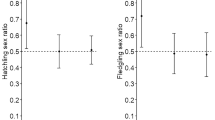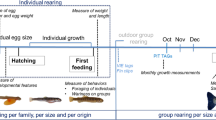Abstract
Different mortality of males and females during early post-hatching development in sexually size-dimorphic bird species is usually attributed to different nutritional requirements of the sexes, because mortality is mostly biassed toward the larger sex. We investigated whether sex-specific embryo mortality in the yellow-legged gull (Larus michahellis), a size-dimorphic seabird, depends on parental condition. To test this, we experimentally modified parental nutritional conditions by supplementary feeding of yellow-legged gulls during egg formation, to evaluate sex-biassed environmental sensitivity of gull embryos. We found that eggs were larger in supplemented clutches, but egg size did not affect embryo survival. Survival of male gull embryos was more related to parental food conditions than was survival of female embryos. Survival of male embryos in supplemented clutches was greater than in unsupplemented clutches whereas survival of female embryos was similar in both groups. Because size at hatching was similar in both sexes our results suggest that male phenotype disadvantage is not exclusively linked to the energy demands of size-dimorphic development at the embryo stage.

Similar content being viewed by others
References
Alonso-Alvarez C, Velando A (2003) Female body condition and brood sex ratio in yellow-legged gulls Larus cachinnans. Ibis 145:220–226
Anderson DJ, Reeve J, Gomez JEM, Weathers WW, Hutson S, Cunningham HV, Bird DM (1993) Sexual size dimorphism and food requirements of nestling birds. Can J Zool 71:2541–2545
Anderson DJ, Reeve J, Bird DM (1997) Sexually dimorphic eggs, nestling growth and sibling competition in American kestrels Falco sparverius. Funct Ecol 11:331–335
Arnold KE, Griffiths R (2003) Sex-specific hatching order, growth rates and fledging success in jackdaws Corvus monedula. J Avian Biol 34:275–281
Balthazart J, Adkins-Regan EA (2003) Sexual differentiation of brain and behaviour in birds. In: Pfaff D, Arnold A, Etgen A, Fahrbach S, Rabin R (eds) Hormones, brain and behaviour. vol IV. Elsevier, The Netherlands
Bolton M (1991) Determinants of chick survival in the lesser black-backed gull: relative contributions of egg size and parental quality. J Anim Ecol 60:949–960
Bolton M, Houston D, Monaghan P (1992) Nutritional constraints on egg formation in the lesser black-backed gull: an experimental study. J Anim Ecol 61:521–532
Bowden RM, Ewert MA, Nelson CE (2000) Environmental sex determination in a reptile varies seasonally and with yolk hormones. Proc R Soc Lond B 267:1745–1749
Brown RGB (1967) Breeding success and population growth in a colony of herring and lesser black-backed gulls Larus argentatus and L. fuscus. Ibis 109:502–515
Charnov EL (1982) The theory of sex allocation. (eds) Princenton University Press, Princenton
Clutton-Brock TH (1991) The evolution of parental care. (eds) Princeton University Press, Princeton
Clutton-Brock TH, Albon SD, Guinness FE (1985) Parental investment and sex differences in juvenile mortality in birds and mammals. Nature 313:131–133
Cooch E, Lank D, Robertson R, Cooke F (1997) Effects of parental age and environmental change on offspring sex ratio in a precocial bird. J Anim Ecol 66:189–202
Cook MI, Monaghan P (2004) Sex differences in embryo development periods and effects on avian hatching patterns. Behav Ecol 15:205–209
Cordero PJ, Griffith SC, Aparicio JM, Parkin DT (2000) Sexual dimorphism in house sparrow eggs. Behav Ecol Sociobiol 48:353–357
Daunt F, Monaghan P, Wanless S, Harris MP, Griffiths R (2001) Sons and daughters: age-specific differences in parental rearing capacities. Funct Ecol 15:211–216
Dijkstra C, Daan S, Pen I (1998) Fledging sex ratios in relation to brood size in size-dimorphic altricial birds. Behav Ecol 9:287–296
Eising CM, Eikenaar C, Schwabl H, Groothuis TGG (2001) Maternal androgens in black-headed gull (Larus ridibundus) eggs: consequences for chick development. Proc Roy Soc Lond B 268:839–846
Eising CM, Visser GH, Müller W, Groothuis TGG (2003) Steroids for free? No metabolic costs of elevated maternal androgen levels in black-headed gull. J Evol Biol 296:3211–3218
Fargallo AJ, Laaksonen T, Pöyri V, Korpimaki E (2002) Inter-sexual differences in the immune response of Eurasian kestrel nestling under food shortage. Ecol Let 5:95–101
Fiala KL (1981) Reproductive cost and the sex ratio in red-winged blackbirds. In: Alexander RD, Tinkle DW (eds) Natural selection and social behaviour. Chiron Press, New York, pp 198–214
Frank SA (1990) Sex-allocation theory for birds and mammals. Annu Rev Ecol Syst 21:13–55
Fridolfsson A, Ellegren H (1999) A simple and universal method for molecular sexing of non-ratite birds. J Avian Biol 30:116–121
Gil D, Graves J, Hazon N, Wells A (1999) Male attractiveness and differential testosterone investment in zebra finch eggs. Science 286:126–128
Godsave SF, Lohmann R, Vloet RPM, Gahr M (2002) Androgen receptors in the embryonic zebra finch hindbrain suggests a function for maternal androgens in the perihatching survival. J Comp Neurol 453:57–70
González-Solis J, Becker PH, Wendeln H, Wink M (2005) Hatching sex ratio and sex specific chick mortality in common terns Sterna hirundo. J Ornithol 146:235–243
Griffiths R (1992) Sex-biassed mortality in the Lesser Black-backed Gull Larus fuscus during the nestling stage. Ibis 134:237–244
Griffiths R, Double MC, Orr K, Dawson RJG (1998) A DNA test to sex most birds. Mol Ecol 7:1071–1075
Groothuis TGG, Schwabl H (2002) The influence of laying sequence and habitat characteristics on maternal yolk hormone levels. Funct Ecol 16:281–289
Grossman CJ (1985) Interactions between the gonadal steroids and the immune system. Science 227:257–261
Hoyt DF (1979) Practical methods of estimating volume and fresh weight of bird eggs. Auk 96:73–77
Kalmbach E, Furness RW, Griffiths R (2005) Sex-biassed environmental sensitivity: natural and experimental evidence from a bird species with larger females. Behav Ecol 16:442–449
Kennamer RA, Alsum SK, Colwell SV (1997) Composition of wood duck eggs in relation to egg size, laying sequence and skipped days of laying. Auk 114:479–487
Klein SL (2000) The effects of hormones on sex differences in infection: from genes to behaviour. Neurosci Biobehav Rev 24:627–638
Krijgsveld K, Dijkstra C, Visser HG, Daan S (1998) Energy requirements for growth in relation to sexual size dimorphism in marsh harrier Circus aeruginosus nestlings. Phys Zool 71:693–702
Lipar JL (2001) Yolk steroids and the development of the hatching muscle in nestling European starlings. J Avian Biol 32:231–238
Lipar JL, Ketterson ED (2000) Maternally derived yolk testosterone enhances the development of the hatching muscle in the red-winged blackbird Aegelius phoeniceus. Proc Roy Soc Lond B 267:2005–2010
Müller W, Groothuis TGG, Dijkstra C (2003) Inter-sexual differences in T-cell-mediated immunity of black-headed gull chicks (Larus ridibundus) depend on the hatching order. Behav Ecol Sociobiol 55:80–86
Müller W, Groothuis TGG, Eising CM, Dijkstra C (2005) An experimental study on the causes of sex-biassed mortality in the black-headed gull – the possible role of testosterone. J Anim Ecol 74:735–741
Munilla I (1997) Estudio de la población y ecología trófica de la gaviota patiamarilla. PhD dissertation. University of Santiago de Compostela, Spain
Nager RG, Monaghan P, Griffiths R, Houston DC, Dawson R (1999) Experimental evidence that offspring sex ratio varies with maternal condition. Proc Natl Acad Sci USA 96:570–573
Nager RG, Monaghan P, Houston DC, Genovart M (2000) Parental condition, brood sex ratio and differential young survival: an experimental study in gulls (Larus fuscus). Behav Ecol Sociobiol 48:452–457
Newton I (1978) Feeding and development of sparrowhawk nestlings. J Zool (Lond) 184:465–487
Olsen NJ, Kovacs WJ (1996) Gonadal steroids and immunity. Endocr Rev 17:369–384
Ottinger MA, Pitts S, Abelnabi MA (2001) Steroid hormones during embryonic development in Japanese quail: plasma, gonadal and adrenal levels. Poultry Sci 80:795–799
Parsons J (1976) Factors determining the number and size of eggs laid by the herring gull. Condor 78:481–492
Petrie M, Schwabl H, Brande-Lavridsen N, Burke T (2001) Sex differences in avian yolk hormone levels. Nature 412:498
Richter W (1983) Balanced sex ratios in dimorphic altricial birds: the contribution of sex-specific growth dynamics. Am Nat 121:158–171
Røskaft E, Slagsvold T (1985) Differential mortality of male and female offspring in experimentally manipulated broods of the rook. J Anim Ecol 54:261–266
Rutkowska J, Cichon M (2002) Maternal investment during egg laying and offspring sex: an experimental study of zebra finches. Anim Behav 64:817–822
Saino N, Bertacche V, Ferrari RP, Martinelli R, Møller AP, Stradi R (2002) Carotenoid concentration in barn swallow eggs is influenced by laying order, maternal infection and paternal ornamentation. Proc R Soc Lond B 269:1729–1733
Sayce JR, Hunt GL (1987) Sex ratios of prefledging western gulls. Auk 104:33–37
von Schantz T, Bensch S, Grahn M, Hasselquist D, Wittzell H (1999) Good genes, oxidative stress and condition-dependent sexual signals. Proc R Soc Lond B 266:1–12
Schwabl H, Mock DW, Gieg JA (1997) A hormonal mechanism for parental favouritism. Nature 386:231
Sheldon BC, Merilä J, Lindgren G, Ellergren H (1998) Gender and environmental sensitivity in nestling collared flycatchers. Ecology 79:1939–1948
Stamps JA (1990) When should avian parents differentially provisions sons and daughters?. Am Nat 135:671–685
Szczys P, Spendelow JA, Nisbet ICT (2005) Sex ratio and early growth patterns of Roseate Tern chicks during five breeding seasons at Falkner Island, Connecticut, USA. Waterbirds 28:273–279
Teather K (1987) Intersexual differences in food consumption by hand-reared great-tailed grackle (Quiscalus mexicanus) nestlings. Auk 104:635–639
Teather K, Weatherhead PJ (1988) Sex specific energy requirements of great-tailed grackle (Quiscalus mexicanus) nestlings. J Anim Ecol 57:658–668
Torres R, Drummond H, (1997) Female-biassed mortality in nestling of a bird with size dimorphism. J Anim Ecol 66:859–865
Trivers RL, Willard DE (1973) Natural selection of parental ability to vary the sex ratio of offspring. Science 179:90–92
Uller T, Olsson M (2003) Prenatal exposure to testosterone increases ectoparasite susceptibility in the common lizard (Lacerta vivipara). Proc Roy Soc Lond B 270:1867–1870
Velando A (2002) Experimental manipulation of maternal effort produces differential effects in sons and daughters: implications for adaptative sex ratios in the blue-footed booby. Behav Ecol 13:443–449
Verboven N, Monaghan P, Evans DM, Schwabl H, Evans N, Whitelaw C, Nager RG (2003) Maternal condition, yolk androgens and offspring performance: a supplemental feeding experiment in the lesser black-backed gull (Larus fuscus). Proc R Soc Lond B 270:2223–2232
Williams TD (1994) Intraspecific variation in egg size and egg composition in birds: effects on offspring fitness. Biol Rev 68:35–59
Whittingham LA, Dunn PO (2001) Survival of extra-pair and within-pair young in tree swallows. Behav Ecol 12:496–500
Young RL, Badyaev AV (2004) Evolution of sex-biassed maternal effects in birds: I. Sex-specific resource allocation among simultaneously growing oocytes. J Evol Biol 17:1355–1366
Acknowledgments
E. Kalmbach, J. González-Solís, and I. Munilla provided helpful comments on the manuscript. Permission and logistical support were provided by Parque Nacional Das Illas Atlánticas de Galicia, Ministerio de Medio Ambiente, and the staff of the Islas Cíes. We are grateful to J.A. Godoy, A. Cordero, V.M. De La Cueva, G. Velo, O. Lorenzo, and R. Sánchez for assistance with determination of the sex of gull chicks, and to L. Sampedro for statistical advice. This study was partially supported by the Spanish project VEM2003–20052 from the Spanish Ministerio de Ciencia y Tecnología. A.V. was supported by a “Ramón y Cajal” fellowship from the Spanish Ministerio de Ciencia y Tecnología.
Author information
Authors and Affiliations
Corresponding author
Additional information
Communicated by P.H. Becker
Rights and permissions
About this article
Cite this article
Pérez, C., Velando, A. & Domínguez, J. Parental food conditions affect sex-specific embryo mortality in the yellow-legged gull (Larus michahellis). J Ornithol 147, 513–519 (2006). https://doi.org/10.1007/s10336-006-0074-4
Received:
Revised:
Accepted:
Published:
Issue Date:
DOI: https://doi.org/10.1007/s10336-006-0074-4




